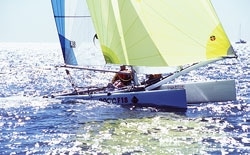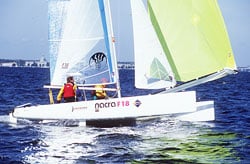
As we sat in the judges chase boat off the Spider buoy near Annapolis, waiting for our next test boat, the Nacra F-18, I spied a very, very fast cat darting across the Chesapeake just to leeward. Within a few seconds she was on us and the skipper, Chip Zenke, stalled the boat from a full plane to a complete stop and smiled. “This,” I said to myself, “is going to be fun.”
I grabbed the helm from the get-go and we threw her into a jibe and jetted off on starboard tack. Instantly, both Chip and I were out on the wire and flying. On the Nacra F-18 (Formula 18 Class Catamaran), the crew trims both main and jib but the jib was set and we really never had to adjust it until we tacked. The main was played constantly in the 1-2 foot chop–ease, trim and ooch seemed to be the protocol. It became obvious that Chip had spent some quality time on the Nacra; before I could ask for a trim, he had done it twice.
The first thing I noticed was how the hulls had a knife-like effect through the waves; every time the leeward hull buried, it seem to just pop right up and do it all over again. The mast rotation limiter was the next item I noticed–you can pre-set this control for the conditions, which is a nice feature when sailing a high-performance cat. At these speeds, there are more important things to concern yourself with than over-rotating the mast.
We decided to throw in a tack, and I found it fairly easy to come off the wire and release myself from the trap while pushing the tiller away. We used a bit of backwind in the jib to get through the wind quicker–a good idea in moderate conditions–and the F-18 simply took off. Chip was out on the wire before Id even hooked in and eventually, I found my way out on the trap. As soon as I did, the boat became leveraged and we really began to boogie.The boat is very clean where both the skipper and crew cross over, and theres a nice tramp organizer used for halyards, food, race instructions and whatever else you may need. Well-designed, you barely even notice its there.

One problem–I wanted more. And I could see a spinnaker launcher, a carbon pole with a hoop at the forward end with a spinnaker sock attached. I turned to Chip and asked if we could fly the chute. He said “We can do whatever you want.” We turned and almost before I knew it the kite was up and trimmed–the launching system is killer. Chip was trimming from the wire and I was hiking on the hull and this seemed to be the proper combination for 12 knots of breeze. A couple of adjustments to the rotation and traveler, and we were really generating some apparent. We were really having some fun, when we heard a snap and noticed the luff tension on the kite change . Wed snapped the pole at the hoop end on the starboard side where the wire runs up from the hull. After taking the kite down–made very easy because of the hoop-and-sock design–I asked Chip if hed seen this happen before. “Never,” he said, and a polling of a few other cat sailors when I got home seemed to echo his statement.
The minor equipment failure didnt matter, the F-18 was going to be a winner in my book and, as it turned out, the other judges agreed. We all felt that the Nacra F-18 was one of the best boats we had sailed during our week of testing. The boat is set up for the more serious/high-performance oriented cat sailors, and costs $12,000, which we thought was a nice price for such a machine. The boat is made under the Formula 18 Class Catamaran Racing (Box Rule) system, which is very popular in Europe. All in all, the boat is a blast to sail and quickly became a favorite to win a category.
Nacra F-18
LOA 18 ft.
Beam 8.5 ft.
Draft 2.8 ft.
DSPL 397 lbs.
SA 42.15m2
www.performancecat.com









